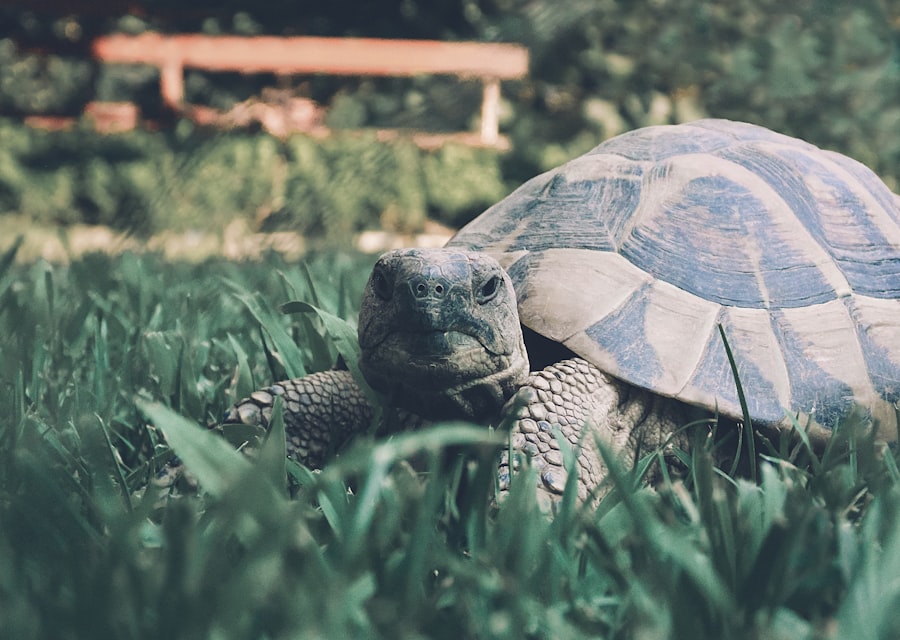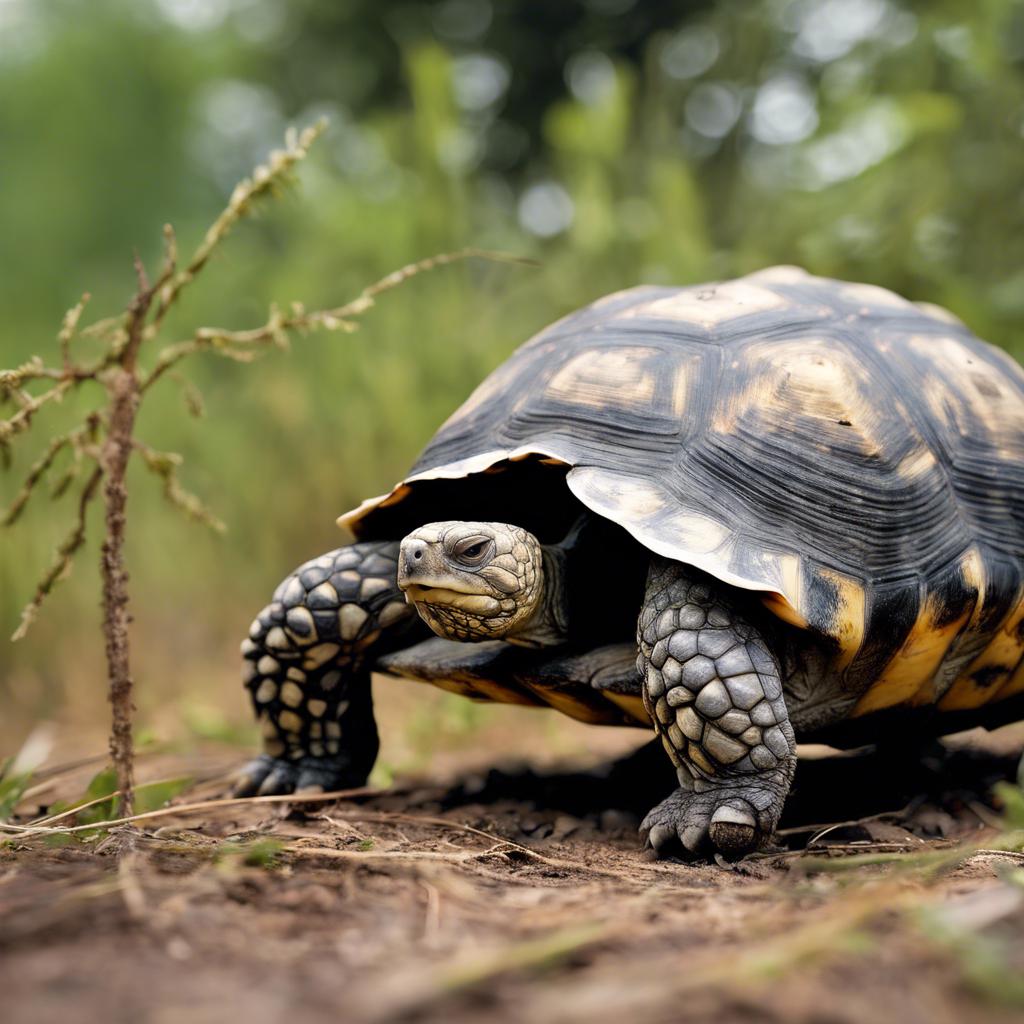Hermann Tortoises are a popular choice for reptile enthusiasts looking for a unique and low-maintenance pet. These small to medium-sized tortoises are native to the Mediterranean region and are known for their friendly and docile nature. Understanding the growth cycle of Hermann Tortoises is crucial for their overall health and well-being as they require specific care and attention at different stages of their development.
Key Takeaways
- Hermann tortoises are a popular species of tortoise kept as pets due to their small size and friendly nature.
- The growth cycle of Hermann tortoises is influenced by factors such as genetics, diet, and environmental conditions.
- Proper nutrition is crucial for healthy growth in Hermann tortoises, with a balanced diet of vegetables, fruits, and protein sources recommended.
- Measuring the size of Hermann tortoises involves taking measurements of their carapace length and width.
- Common misconceptions about Hermann tortoise growth include the belief that they will continue to grow indefinitely and that a larger size is always better.
Understanding the Growth Cycle of Hermann Tortoises
The growth cycle of Hermann Tortoises can be divided into several stages. The first stage is the hatchling stage, which begins when the tortoise emerges from its egg. At this stage, the tortoise is very small, usually measuring around 1-2 inches in length. Over the next few years, the tortoise will go through a period of rapid growth, known as the juvenile stage. During this stage, the tortoise will grow significantly in size and weight.
The next stage is the subadult stage, which occurs when the tortoise reaches sexual maturity. This stage is characterized by a slower rate of growth compared to the juvenile stage. Finally, the adult stage is reached when the tortoise has reached its full size and has stopped growing. The length of time it takes for a Hermann Tortoise to reach maturity can vary depending on various factors such as genetics, diet, and environmental conditions.
Factors that Affect the Size of Hermann Tortoises
Several factors can influence the size of Hermann Tortoises. Genetics play a significant role in determining the ultimate size of a tortoise. Some individuals may have genes that predispose them to be larger or smaller than average. Diet also plays a crucial role in determining the size of a Hermann Tortoise. A balanced and nutritious diet is essential for healthy growth and development.
Environmental factors such as temperature and humidity can also impact the size of a Hermann Tortoise. Tortoises that are kept in an environment that is too cold or too hot may experience stunted growth. It is important to provide a suitable habitat with the appropriate temperature and humidity levels to ensure optimal growth.
Average Size of Hermann Tortoises: A Comprehensive Overview
The average size of Hermann Tortoises can vary depending on several factors. Males tend to be smaller than females, with adult males typically measuring around 6-8 inches in length and weighing between 1-2 pounds. Adult females, on the other hand, are larger, measuring around 8-10 inches in length and weighing between 2-4 pounds.
Size can also vary depending on the subspecies of Hermann Tortoise. There are two main subspecies: the Western Hermann Tortoise (Testudo hermanni hermanni) and the Eastern Hermann Tortoise (Testudo hermanni boettgeri). The Western subspecies tends to be slightly larger than the Eastern subspecies, with adult males measuring around 7-9 inches in length and adult females measuring around 9-11 inches in length.
Size can also vary depending on the age of the tortoise. Hatchlings are typically very small, measuring only a few inches in length. As they grow, they will go through periods of rapid growth before eventually reaching their full size as adults. It is important to monitor the growth of a Hermann Tortoise and provide appropriate care and nutrition at each stage of its development.
How to Measure the Size of Hermann Tortoises
Measuring the size of a Hermann Tortoise is relatively straightforward. To measure the length of the tortoise, place a ruler or tape measure along its shell from the tip of its head to the end of its tail. Be sure to measure along the curve of the shell for an accurate measurement. To measure the weight of the tortoise, use a small scale designed for weighing reptiles. Place the tortoise on the scale and record the weight.
It is important to note that measuring the size of a tortoise is not just about length and weight. The overall health and condition of the tortoise should also be taken into consideration. Look for signs of malnutrition or illness, such as a sunken or swollen shell, abnormal growths, or changes in behavior. If you have any concerns about the size or health of your Hermann Tortoise, it is best to consult with a veterinarian who specializes in reptiles.
The Importance of Proper Nutrition for Hermann Tortoise Growth

Proper nutrition is essential for healthy growth and development in Hermann Tortoises. These reptiles require a balanced diet that includes a variety of foods to ensure they receive all the necessary nutrients. A diet rich in calcium, vitamins, and minerals is crucial for strong bones and shell development.
Hermann Tortoises are herbivores and primarily eat plant matter. Their diet should consist of a variety of leafy greens such as dandelion greens, collard greens, and kale. They should also be offered a variety of vegetables and fruits, such as carrots, bell peppers, and strawberries. It is important to avoid feeding them foods that are high in oxalates, such as spinach and rhubarb, as these can interfere with calcium absorption.
Supplementation may also be necessary to ensure proper nutrition. Calcium supplements can be dusted onto their food to provide an additional source of this essential mineral. It is important to consult with a veterinarian or reptile specialist to determine the appropriate supplementation for your Hermann Tortoise.
How to Ensure Healthy Growth in Hermann Tortoises
Providing a healthy environment is crucial for ensuring healthy growth in Hermann Tortoises. They require a suitable habitat that mimics their natural environment. This includes a spacious enclosure with plenty of room to roam, as well as a basking area where they can soak up heat and UVB light.
Temperature and humidity levels should be carefully monitored and maintained within the appropriate range. The temperature should be kept between 80-90 degrees Fahrenheit during the day, with a cooler area provided for the tortoise to retreat to if needed. Humidity levels should be kept between 50-70% to prevent dehydration.
Regular monitoring of the tortoise's growth is also important. Keep track of their length and weight over time to ensure they are growing at a healthy rate. If there are any concerns about their growth or overall health, it is best to consult with a veterinarian who specializes in reptiles.
Common Misconceptions about Hermann Tortoise Growth
There are several common misconceptions about the growth of Hermann Tortoises that need to be clarified. One misconception is that tortoises experience growth spurts. While tortoises do go through periods of rapid growth, it is not accurate to describe these as growth spurts. Growth in tortoises is generally slow and steady, with occasional periods of more rapid growth during the juvenile stage.
Another misconception is that feeding a tortoise more will make it grow faster. Overfeeding can actually lead to health problems such as obesity and shell deformities. It is important to provide a balanced and nutritious diet in appropriate portions to ensure healthy growth.
Potential Health Issues Related to Hermann Tortoise Size
Improper growth can lead to various health issues in Hermann Tortoises. One common problem is metabolic bone disease, which occurs when the tortoise does not receive enough calcium or vitamin D3. This can result in weak bones and shell deformities. Another potential issue is shell pyramiding, which is characterized by the formation of pyramid-like growths on the shell. This can be caused by a variety of factors, including improper diet and environmental conditions.
It is important to prevent and treat these health issues by providing a balanced diet, appropriate supplementation, and a suitable habitat. Regular veterinary check-ups are also recommended to monitor the tortoise's health and address any potential issues early on.
Caring for Your Hermann Tortoise throughout its Life Cycle
Caring for a Hermann Tortoise requires a thorough understanding of their growth cycle and specific care needs at each stage of their development. By providing a suitable habitat, a balanced diet, and regular monitoring, you can ensure healthy growth and development in your tortoise. Remember to consult with a veterinarian or reptile specialist if you have any concerns about the size or health of your Hermann Tortoise. With proper care and attention, your tortoise can live a long and healthy life.
If you're interested in learning about the size of Hermann tortoises, you might also want to check out this informative article on Reptile Wizard's website: How Big Do Hermann Tortoises Get? This article provides valuable insights into the growth and development of these fascinating creatures, helping you understand their size potential and how to properly care for them.
FAQs
What is a Hermann tortoise?
A Hermann tortoise is a species of tortoise native to southern Europe.
How big do Hermann tortoises get?
Hermann tortoises can grow up to 8-10 inches in length and weigh up to 4-5 pounds.
What is the lifespan of a Hermann tortoise?
Hermann tortoises can live up to 50-100 years in captivity.
What do Hermann tortoises eat?
Hermann tortoises are herbivores and primarily eat grasses, weeds, and leafy greens.
What is the habitat of a Hermann tortoise?
Hermann tortoises are found in dry, rocky habitats such as scrublands, grasslands, and oak forests.
What is the breeding season for Hermann tortoises?
Hermann tortoises typically breed in the spring and summer months.
Do Hermann tortoises make good pets?
Hermann tortoises can make good pets for experienced reptile owners who can provide them with proper care and a suitable habitat.

